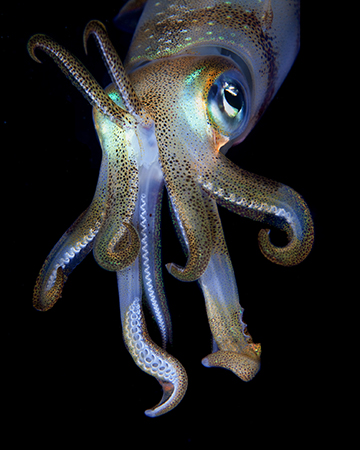
[Image: Getty Images]
Researchers have been studying cephalopods, such as squid and octopuses, for decades to try and understand the photophysics behind these creatures’ camouflage capabilities, yet the science underlying this biological phenomenon remains elusory. Now, we may be one step closer to unraveling the mystery. A research team led by Leila Deravi at Northeastern University, Mass., USA, has isolated the nanoparticles on squid’s skin and used them to create light-scattering polymer fibers (Adv. Opt. Mater., doi: 10.1002/adom.201701369). The team believes that these fibers could be woven into wearable, flexible textiles capable of adaptive coloration.
Masters of disguise
Squid have optical organs called chromatophores that appear as hundreds of multi-colored freckles on the skin, and that rapidly open and close to give rise to variations in visible color. Underneath the chromatophores lies a layer of reflective, mirror-like iridophores. Together these organs regulate the reflection of visible light off of the body surface.
The researchers isolated the nanostructured proteins and pigments that populate cephalopods’ optical organs and studied them, concluding that light scattering off of the nanoparticles plays a significant role during adaptive coloration. Up to now, scattering has been ignored, as past studies have assumed that all light not reflected off the skin is absorbed. The team discovered that the pigment granules can scatter both infrared and visible light, which enhances brightness and light absorption and affects color perception.
“From a scientific and technical engineering perspective, understanding how light scattering affects color is very important,” Richard Osgood, a collaborator from the U.S. Army Natick Soldier Research, Development and Engineering Center, said in a press release accompanying the work. “This is an exciting new development in the field of optics in biology.”
Capturing it on film
The researchers wanted to better understand how the chromatophores function during the act of camouflage, so they began by constructing films that distributed the particles in multiple layers and thicknesses. They used techniques such as scanning electron microscopy (SEM) and total integrated diffuse spectroscopy (TIDS) to observe the effects of granular layering and intergranular spacing on visible color in the films, as well as to better account for the role of light scattering.
Altogether, the data collected by the team indicated that granule thickness and distribution contributed to a range of visible colors within the films. The researchers also concluded that both forward and backward scattering facilitate light penetration to and from the optical organs, which leads to color enhancements in the squid skin during adaptive coloration.
Next, the team devised a system comprising the nanoparticles taken from the squid skin and a mirror, mimicking the setup of squid’s chromatophores and iridophores. The researchers were able to further enhance the perceived color by scattering light through and off the particles.
Toward wearable materials
As a proof of concept, the researchers made spools of fibers from the 500-nm particles (150 times smaller than the diameter of a human hair). “We were particularly interested,” the researchers write, “in combining granules into the central core of polymer, melt-extruded fibers,” to see whether they could embed visible and infrared light manipulation into a manufacturing-friendly platform suitable for textiles, displays and communication applications.
The team notes that its preliminary analysis of the fibers suggests “a unique material that not only provides visible color but can also reflect color due to forward and backward scattering.” The high scattering in the near-infrared and shortwave-infrared regions, the researchers add, indicates that the fibers could conceivably replace traditional infrared colorants in future wearable materials. The potential applications could also include military applications of adaptive coloration, according to Osgood.
